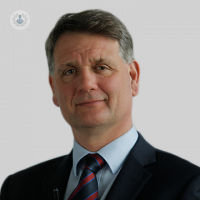Q&A about golfing injuries with an orthopaedic consultant
Escrito por:I am a consultant orthopaedic surgeon who, like 4 million people in the UK, participates in playing the sport of golf. It is estimated that out of the 10% of golf players who play 12 or more games a year, 15-20% may end up with an injury as a result of playing golf at some stage of their playing career.
What are the five most common golf injuries?
- Lower back pain
- Golfers elbow
- Shoulder injuries
- Painful hip and knee
- Foot and Ankle injuries
How do they happen and how can they be treated?
Lower back pain:
It may not be surprising that swinging a club for 4-5 hours, or carrying a heavy golf bag, may cause lower back pain. These activities can put stress on the vertebral column, which could result in lumbar disc disease and/or neck problems.
Golfers elbow:
Golfers elbow is caused by inflammation of the tendons on the inner aspect of the arm, also known as tendonitis. This is more common as we get older and occurs more frequently when performing repetitive movements, placing additional stress on a tendon. A technically improper ‘swing’ may be the cause, which can also affect joints such as the wrist. Treatment for golfers elbow focuses on resting the injured tendon to allow healing, decreasing inflammation and promoting muscle strength.
Shoulder injuries
Golfers are also more prone to conditions of the shoulder such as, tendinitis, bursitis, and tears in the rotator cuff. The pain may be felt during all phases of the golf swing and may lead to having pain at night.
Painful hip and knee:
Hips can also be injured whilst playing golf due to sharp rotational actions. Conditions such as trochanteric bursitis, psoas tendonitis and damage to the labrum of the hip socket can occur. Arthritis of the hip can be very limiting and the high success rate of joint replacement surgery has kept many a player in the game.
The rotational movements of golf also affect the knees. Damage to the internal structures can occur and can happen more frequently in people with some degenerative change (arthritis) of the knee joint.
Foot and ankle injuries:
The power behind the golf swing is generated by the legs, which is directly transferred to the ground by the feet. This repetitive action may cause the feet to become painful. Walking on an uneven surface in poor quality shoes may also be problematic. Sprains in the ankles, tendinitis in the ankle and foot bones, and inflammation and blisters are all injuries that can be sustained when playing golf. Wearing properly fitted golf shoes and improving swing mechanics are the best ways to prevent foot and ankle injuries.
In many cases the use of anti-inflammatories, paracetamol and the help of a specialised physiotherapist may be all that is required. Occasionally further investigations will be undertaken or specialist injections will be administered.
How do we prevent a golf related injury?
One of the most productive ways to prevent injury from golf is to perform warm-up exercises as a routine. If you are unlucky enough to suffer one of the recognised golfing injuries, and have experienced symptoms for 4 – 6 weeks, please seek advice from a qualified professional in the relevant specialty. However, please enjoy your golf and try to stay away from injuries.
If you are concerned you may have sustained a golf-related injury, make an appointment with a specialist.



